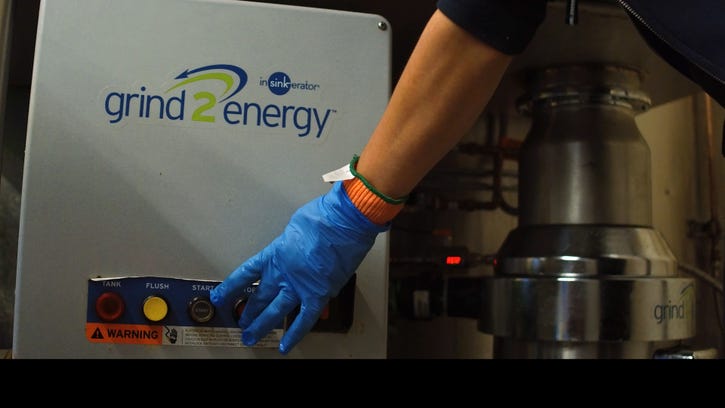Several universities are turning toward technology to help them reduce the amount of food waste they generate.
On average, a residential college student generates almost 142 pounds of food waste each year, according to an analysis done in May 2018 by Massachusetts-based RecyclingWorks. A commuter or non-residential student can generate about 38 pounds per year.
An institution that has a total of 1,000 residential and 500 non-residential students enrolled can produce upwards of 161,000 pounds of food waste per year. To reduce food waste at their institutions, several U.S. universities have turned to technology to tackle this issue.
Oregon State University’s (OSU) Housing and Dining Services (UHDS) implemented the Beaverton, Ore.-based Leanpath technology in February. This was in addition to several steps toward reducing wasted food, such as à la carte pricing and partnerships with local food banks that OSU has applied over the years.
“We primarily use Leanpath 360 trackers, which are essentially scales with a camera and digital interface,” says Chris Anderson, interim general manager for the Marketplace West dining center at UHDS, based in Corvallis, Ore. “They allow the weights and images of wasted food to be catalogued by source and item. We can then use the software platform to create meaningful reports, helping us identify trends that may otherwise be difficult to assess over stretches of time.”
The Leanpath technology was implemented in every potential waste-producing area, including all three main dining centers, the catering department and in three satellite retail locations, for a total of seven devices.
According to Kerry Paterson, director of residential dining and catering for OSU’s UHDS, a grant assisted in purchasing the equipment and paying the first year’s fees.
“Our goal is that this effort will be self-funded via the reduction in cost of goods we hope to see from the reduction in waste,” he says.
In 2017, UHDS received an Oregon Department of Environmental Quality Materials Management grant that targeted the reduction of wasted food.
“It’s no secret to any restaurant or restaurant manager that wasted food equals wasted resources and wasted money,” says Anderson. “Typically, foodservice affords relatively slim profit margins, and efficient use of food is a critical piece of remaining financially solvent.”
Through Leanpath, UHDS is trying to collect data on all pre-consumer food before it leaves the building, whether that is food destined for a foodshare program or for a compost pile.
So far, UHDS has not made any sweeping changes based on the Leanpath trackers, but it has used this information to coach food-producing staff on techniques and production methods that can help in some areas. It also has provided insights on where ordering is misaligned with true need.
“It has also allowed our chefs to examine how much food waste we’re producing each meal and then make adjustments for more efficient menus,” says Paterson. “For example, the photos the system collects allow the chefs to examine if a product really needs to be composted or trashed or whether can it be repurposed somehow—perhaps used in another dish or donated via our on-campus food pantry.”
The University of Notre Dame based in South Bend, Ind., installed three Grind2Energy systems at its catering operation and two dining halls. The university also has partnered with Cultivate to promote food recovery, create a food rescue student group and support a “feed the cows” program to provide outlets for consumable food waste.
“Grind2Energy aligns with the University of Notre Dame’s Comprehensive Sustainability Strategy and our Catholic mission by being stewards of our environment,” says Allison Mihalich, senior program director of sustainability for the University of Notre Dame. “Food waste is our largest source of waste; as we look at reducing waste on campus, we prioritized food waste reduction. The Grind2Energy technology is helping us make progress toward our waste reduction goals while also reducing emissions and creating electricity.”
Grind2Energy is a food scrap recycling system consisting of two primary components—a processing table and a holding tank. The processing table utilizes a 10-horsepower grinder engineered by InSinkErator to macerate the scraps into a slurried format.

“Grind2Energy is Internet of Things enabled and provides us a means of measuring the levels of food scraps processed by each of the three locations at Notre Dame via an online dashboard,” says Doug Brokaw, director of sales for Emerson Grind2Energy based in Mt. Pleasant, Wis. “As we gain an understanding of what and how much we’re processing, we can better understand the impact of our efforts to then turn our attention to source reduction.”
The Grind2Energy technology diverts non-consumable food waste from entering the landfill by grinding the food into a slurry, which is then pumped into a 5,000-gallon tank that is fully enclosed. Sensors in the tank alert the university’s septic hauler and on-campus staff when the tank is approaching full so a pickup can be scheduled.
“Our septic hauler, Johnson Johns & Septic, recommended Homestead Dairy,” says Mihalich. “Homestead was already utilizing anaerobic digestion for years and previously hosted Notre Dame for a site visit. The beauty of the Grind2Energy solution is that any anaerobic digester benefits from the methane value of food waste.”
The food is then pumped out of the tank and transported to the Homestead Dairy Farm anaerobic digester where it is converted into methane and then electricity. The electricity produced goes to heat the farm operation and excess is sold to the utility. Byproducts of this process are utilized for cattle bedding and liquid fertilizer making this a closed loop solution, adds Mihalich.
“Our 400 tons of food waste per year is projected to create approximately 77,00 kilowatt hours. The Homestead operation is much larger and can produce up to 1 megawatt per day,” she says.
About the Author(s)
You May Also Like


